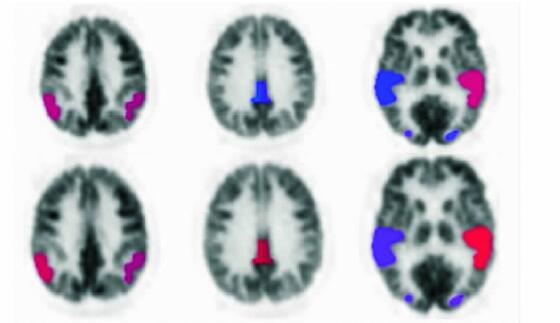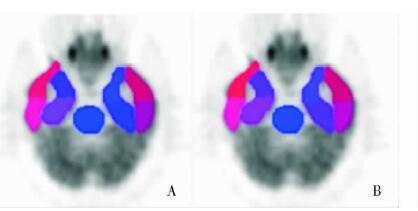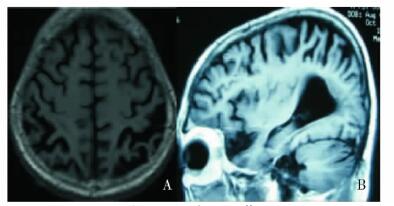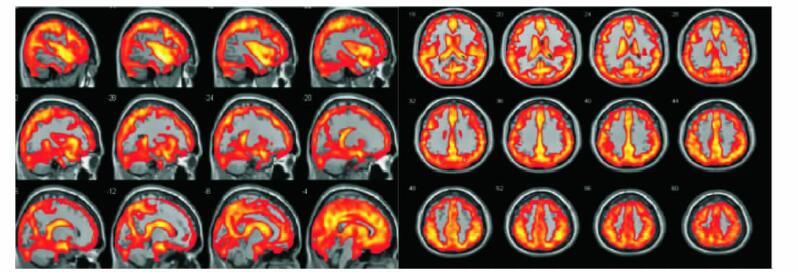Changes in Parietal Lobe as A Typical Imaging Finding in Patients with Alzheimer's Disease
-
摘要:目的 观察不同脑区代谢及结构改变与阿尔茨海默病(Alzheimer's disease, AD)的关系, 探讨内侧颞叶萎缩外其他脑区结构变化对AD的诊断价值。方法 选择2007年1月至2010年12月北京协和医院神经科门诊拟诊变性病性痴呆患者123例, 进行梯度递进神经心理评价, 对可能AD及有可能AD患者采用脱氧葡萄糖正电子发射体层摄影术(fluorodeoxy glucose-positron emission tomography, FDG-PET)评价脑代谢功能, 视图直接观察、SUV值测定及NeuroQ分析3种方法评价不同脑区的变化; 3D MRI进行脑结构检测, 常规图像观察, 基于体素的形态(voxel-based morphometric, VBM)及扩散张量成像(diffusion tensor imaging, DTI)具体分析。结果 123例拟诊变性病性痴呆患者经梯度递进神经心理评价及临床鉴别诊断后符合可能AD患者41例, 有可能AD患者43例。FDG-PET显示84例可能和有可能AD患者低代谢区100%出现在顶叶, 79.8%(67例)在后扣带回, 71.4%(60例)出现在后部颞顶区, 61.9%(52例)在内侧颞叶。MRI显示顶叶萎缩67.9%(57例双侧)~84.5%(71例单侧), 24例可用VBM分析的MRI显示顶叶萎缩明显重于对照组。12例临床可能的额颞叶痴呆患者未发现顶叶低代谢和萎缩。结论 功能影像显示顶叶低代谢和结构影像显示顶叶萎缩对AD诊断及鉴别诊断有重要价值。
-
关键词:
- 阿尔茨海默病 /
- 痴呆 /
- 顶叶 /
- 脱氧葡萄糖正电子发射体层摄影术 /
- 磁共振成像
Abstract:Objective To observe the metabolic and structural changes in different cerebral areas in patients with Alzheimer's disease (AD) and to explore the value of the changes in parietal lobe in the diagnosis of AD.Methods Totally 123 patients with suspected AD who were assessed in our hospital from January 2007 to December 2010 were entrolled in this study. The brain functions were evaluaed using fluorodeoxy glucose-positron emission tomography (FDG-PET). Changes in different cerebral areas were evaluated by direct observation, SUV measurement, and NeuroQ analysis. The brain structure was obseved under three-dimensional megnatic resonance imaging (MRI), which were further anlysed via voxel-based morphometric (VBM) and diffusion tensor imaging (DTI).Results Totally 41 patients were diagnosed as probable AD and 43 as possible AD. FDG-PET revealed that, among these 84 patients, hypomatebolism was detected in the parietal lobe of all patients (100%), and also in posterior cingutate (79.8%), posterior temporoparietal lobe (71.4%), and medial temple lobe (61.9%). MRI showed atrophy on parietal lobe in 67.9% (57 cases of both sides) to 84.5% (71 cases of single side) of the patients. Among 24 patients who can be assessed using VBM, MRI showed the atrophy of parietal lobe was much more obvious. No hypomatebolism or atrophy of the parietal lobe was found in 12 clinically probable frontotemporal dementia patients.Conclusion Hypometabolism (as shown by functional imaging) and atrophy (as shown by structural imaging) of the parietal lobe can be suggestive for the diagnosis of AD. -
在阿尔茨海默病(Alzheimer's disease,AD)临床诊断中,人们越来越多地发现患者的结构影像未显示海马萎缩,且海马萎缩可见于额颞叶痴呆。笔者曾观察过有认知功能进行性减退临床可能AD患者的影像学资料,结果病初及随访MRI均无海马萎缩,但有顶叶低代谢和萎缩。众所周知,淀粉样蛋白沉积形成的老年斑多数分布在新皮层,高度磷酸化的TUA蛋白沉积形成的神经原纤维缠结也不仅存在于内侧颞叶[1-2]。为此,笔者建立了系列研究:有病理基础的不同类型内侧颞叶萎缩与认知功能变化的相关性,不同脑叶与AD疾病进展的相关性,本文报告AD患者的顶叶变化。
对象和方法
对象
按照美国国立神经病及语言交流障碍和卒中研究所-阿尔茨海默病及相关疾病学会(National Institute of Neurological and Communicative Disorders and Stroke-Alzheimer's Disease and Related Disorders Association,NINCDSADRDA)诊断标准,选取2007年1月至2010年12月北京协和医院神经科门诊拟诊变性病性痴呆患者123例,经过详细的临床病史、疾病过程询问及神经系统检查后进行规范的梯度递进认知功能评价。
认知功能评价
选用简易精神状态量表(mini-mental state examination,MMSE)、蒙特利尔认知评估量表(Montreal cognitive assessment,MoCA)进行认知功能筛查,日常生活能力量表(activities of daily living,ADL)评价生活适应能力,医院焦虑抑郁量表(hospital anxiety and depression scale,HADS)评价情绪,再应用北京协和医院认知功能评价系统进行综合认知功能评价; 若患者有某项突出的认知功能障碍再进行专项评价,如汉语失语症、视空间功能评价等[3]。同时进行详细的鉴别诊断,除血常规、肝肾功能外特别注意感染如梅毒,代谢异常如甲状腺功能低下或亢进,营养障碍如维生素缺乏,中毒如酒精中毒、有机溶剂中毒、一氧化碳中毒等,还特别注意除外副肿瘤综合征等。将应用同样诊断程序临床诊断额颞叶痴呆作为不同类型痴呆的对照。
脱氧葡萄糖正电子发射体层摄影术检测
脱氧葡萄糖正电子发射体层摄影术(fluorodeoxy glucose-positron emission tomography,FDG-PET)检测由专人完成,然后由2位以上观察者进行低代谢区评价,并测SUV值,设桥脑基底部SUV值为全脑SUV值的参照。再由专门的操作者单盲(不知道患者诊断)进行专项分析(NeuroQ)。在分析脑区时将通常观察中归为后部颞顶的区域进一步细分为顶叶和剪除顶叶后的单纯后部颞顶区。
D MRI检测
检查GRE T1和T2-FLARE基于体素的形态(voxel-based morphometric,VBM)、扩散张量成像(diffusion tensor imaging,DTI)和静息态功能,由专人分析结果,VBM同年龄组正常对照由核磁共振室提供。MRI显示顶叶萎缩通过轴位和矢状位图像确定。
结果
123例拟诊变性病性痴呆患者经检测41例符合可能AD,43例符合有可能AD。
FDG-PET显示,84例(100%)可能AD和有可能AD患者均出现顶叶低代谢,67例(79. 8%)后扣带回低代谢,60例(71. 4%)后颞顶低代谢,52例(61. 9%)内侧颞叶低代谢。2例动态随访患者顶叶低代谢先于后扣带回(图 1),且患者随着随访期延长逐渐出现外部颞叶继而内部颞叶低代谢(图 2)。
MRI显示矢状位自中线向两侧分别有超过4个层面萎缩,轴位自顶向下顶叶2个层面以上萎缩,内侧顶叶萎缩更重要。84例可能AD和有可能AD患者MRI图像显示,顶叶萎缩为67. 9% (57例双侧) ~ 84. 5% (71例单侧) (图 3); 而内侧颞叶萎缩(常规观察的萎缩)仅为26. 2% (22例双侧) ~ 35. 7% (30例单侧)。24例可用VBM分析患者的MRI显示顶叶萎缩明显重于对照组(图 4),且至少不轻于内侧颞叶萎缩。临床可能的12例额颞叶痴呆起病初期既没有顶叶萎缩也没有顶叶低代谢。额叶和外侧颞叶,后部颞顶区及内侧颞叶低代谢可见于AD和额颞叶痴呆。
讨论
在AD临床诊断和病理诊断中,海马及内侧颞叶变化具有重要的价值,且已得到广泛应用。代谢影像在10年前就证实了顶叶和后扣带回等部位代谢改变对AD诊断的重要价值。病理研究亦早已显示AD相关的变化不仅仅在内侧颞叶,β淀粉样蛋白沉积形成的老年斑多数分布在新皮层。随着临床研究手段的进展,在AD诊断中不同脑区的作用会越来越多地被认识到。本研究结果显示可能和有可能AD患者顶叶糖代谢减低出现率最高,且是最早出现的低代谢脑区之一,同时有明确的顶叶和/或内侧颞叶萎缩; 而额颞叶痴呆患者既没有突出的顶叶低代谢,也没有顶叶及内侧颞叶萎缩,提示顶叶影像学变化是AD的重要变化之一,可用于痴呆的鉴别诊断。笔者这一观点于2011年3月在加拿大召开的AD国际会议上通过大会发言报告。2011年5月AD协会发表的AD新诊断标准,除了指出MRI颞叶萎缩对AD的诊断价值外,也阐明了顶叶萎缩对提高诊断级别的价值[2, 4-6]。
2011年Womack等[7]曾提出内侧颞叶不是AD患者脑代谢异常的起源,并认为由后扣带回首发而后扩散至内侧颞叶。本研究也显示顶叶和后部颞顶区及外侧颞叶低代谢均早于内侧颞叶,只是本研究结果显示顶叶更早于后扣带回。本组患者均显示内侧颞叶低代谢发生率低于顶叶、额叶、外侧颞叶、后扣带回,动态随访患者也证实低代谢由顶叶/后扣带回/后部颞顶叶/外侧颞叶向内侧颞叶发展的过程。越来越多的研究证实了其低代谢的迟发性。
以往研究在分析不同脑区的糖代谢时,将顶叶与颞叶划为颞顶一个区域分析,敏感性为93. 6%,本研究在应用NeuroQ分析时,将颞顶分为顶叶与后部颞顶区,顶叶在AD患者的低代谢发生率近100%,顶叶低代谢在AD更敏感且与其更相关。
MRI示顶叶萎缩偶可见于非痴呆患者,但笔者目前有限地应用MRI VBM与同龄正常人进行组间对照的皮层结构评价资料(24例)证实,可能AD患者具有更突出的顶叶萎缩。2011年有关老年随访研究报道,顶叶萎缩患者部分发展为AD痴呆[8]。为此,本研究尚需进行以下两方面的扩展研究:更多的AD及其他类型变性病性痴呆患者的VBM研究; 有顶叶萎缩但尚无痴呆患者的长期随访研究。
第一、第二作者对本文贡献一致 -
[1] Goedert M, Spillantini MG. A century of Alzheimer's disease[J]. Science, 2006, 314:777-781. DOI: 10.1126/science.1132814
[2] Hyman BT, Phelps CH, Beach TG, et al. National Institute on Aging-Alzheimer's Association guidelines for the neuropathologic assessment of Alzheimer's disease[J]. Alzheimers Dement, 2012, 8:1-13 DOI: 10.1016/j.jalz.2011.10.007
[3] 高晶, 李方, 朱朝晖, 等.非流利失语型额颞叶痴呆患者神经心理学特征及皮质代谢功能变化[J].中华神经科杂志, 2009, 42:733-736. http://www.wanfangdata.com.cn/details/detail.do?_type=perio&id=zhsjk200911005 [4] Jack CR Jr, Albert MS, Knopman DS, et al. Introduction to the recommendations from the National Insitute on AgingAlzheimer's Association workgroups on diagnostic gurdelines for Alzheimer's disease[J]. Alzheimers Dement, 2011, 7:257-262. DOI: 10.1016/j.jalz.2011.03.004
[5] McKhann GM, Knopman DS, Chertkow H, et al. The diagnosis of dementis due to Alzheimer's disease:recommendations from the National Insititute on Aging-Alzheimer's Association workgroups on diagnostic guidelines for Alzheimer's disease[J]. Alzheimers Dement, 2011, 7:263-269. DOI: 10.1016/j.jalz.2011.03.005
[6] Gao J, Li F, Feng F, et al. Parietal lobe changing are the important image changing of AD[C]//26th International Conference of Alzheimer's Disease International programme and abstract booklet, Toronto (Canada), 2011. London: Alzheimer's Disease International & Toronto: Alzheimer Society of Canada, 2011: 60.
[7] Womack KB, Diaz-Arrastia R, Aizenstein HJ, et al. Temporoparietal hypometabolism in frontotemporal lobar degeneration and associated imaging diagnostic errors[J]. Arch Neurol, 2011, 68:329-337. http://www.wanfangdata.com.cn/details/detail.do?_type=perio&id=1df01cbc20b01ec64f64d77a2c3c58f3
[8] Jacobs HI, Van Boxtel MP, Uylings HB, et al. Atrophy of the parietal lobe in preclinical dementia[J]. Brain Cogn, 2011, 75:154-163. DOI: 10.1016/j.bandc.2010.11.003
-
期刊类型引用(9)
1. 郭晓睿,李蕾,张蓉,郭丹,谢彧之,付强,周寒梅. 青少年特发性脊柱侧凸病人围术期麻醉管理的最佳证据总结. 循证护理. 2024(02): 210-217 .  百度学术
百度学术
2. 陶尊晓,朱春爽,尹翠翠,范燕燕. 青少年特发性脊柱侧凸患者围手术期加速康复管理的最佳证据总结. 中华现代护理杂志. 2024(02): 183-190 .  百度学术
百度学术
3. 李方方,宋葆云,苏豫囡. ERAS理念的围术期护理在脊柱畸形矫形术患者中的应用. 齐鲁护理杂志. 2024(10): 120-123 .  百度学术
百度学术
4. 李柯蓉,孟繁媛,赵智,陈茉弦,敖丽娟. 特发性脊柱侧凸手术患者功能障碍及康复治疗研究进展. 四川医学. 2024(09): 1027-1032 .  百度学术
百度学术
5. 杨莹,田雪,陈亚萍,赵钇伟,李子全. Ⅰ型神经纤维瘤病性胸腰椎脊柱侧后凸的围术期临床疗效及护理研究. 罕见病研究. 2023(04): 539-546 .  百度学术
百度学术
6. 王向阳,刘永辉,石洋,崔宏勋. 加速康复外科理念在脊柱手术围手术期应用进展. 中国疗养医学. 2022(01): 51-53 .  百度学术
百度学术
7. 佟冰渡,李高洋,田雪,李杨,徐涛,陈亚萍. 青少年特发性脊柱侧凸患者术后首次离床活动直立不耐受的现状及影响因素分析. 中国护理管理. 2022(01): 17-21 .  百度学术
百度学术
8. 佟冰渡,苏晓静,陈佳丽,黄洁,郑金凤,朱婷,宁宁,鲁雪梅,高远,郭娜,陈亚萍. 青少年特发性脊柱侧凸患者围手术期护理专家共识. 中华骨与关节外科杂志. 2022(11): 822-830 .  百度学术
百度学术
9. 王薇,李颂,赵慧,王琪. 加速康复外科理念在青少年特发性脊柱侧凸围术期的应用. 骨科. 2021(05): 462-466 .  百度学术
百度学术
其他类型引用(1)

 作者投稿
作者投稿 专家审稿
专家审稿 编辑办公
编辑办公 邮件订阅
邮件订阅 RSS
RSS


 下载:
下载:














